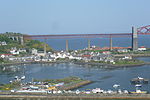Inverkeithing

Inverkeithing ( ; Scottish Gaelic: Inbhir Chèitinn) is a coastal town and parish in Fife, Scotland, on the Firth of Forth, 9½ miles north west of Edinburgh city centre. A town of ancient origin, Inverkeithing was given Royal burgh status during the reign of Malcolm IV in the 12th century. It was an important centre of trade during the Middle Ages, and its industrial heritage built on quarrying and ship breaking goes back to the 19th century. The town centre is now a conservation area. The town has an estimated population of 4,820 (2020), while the civil parish has a population of 8,090 (2011).Today, Inverkeithing is a busy commuter hub: its railway station is a main stop for trains on the Fife Circle Line that runs north from Edinburgh, and it is home to the Ferrytoll Park & Ride, which offers bus connections across the Forth and to the rest of Fife. Inverkeithing is a commuter town of Edinburgh. Inverkeithing lies on the Fife Coastal Path, one of Scotland's Great Trails.
Excerpt from the Wikipedia article Inverkeithing (License: CC BY-SA 3.0, Authors, Images).Inverkeithing
Church Street,
Geographical coordinates (GPS) Address Nearby Places Show on map
Geographical coordinates (GPS)
| Latitude | Longitude |
|---|---|
| N 56.0318 ° | E -3.39713 ° |
Address
Church Street 8-12
KY11 1LJ
Scotland, United Kingdom
Open on Google Maps









